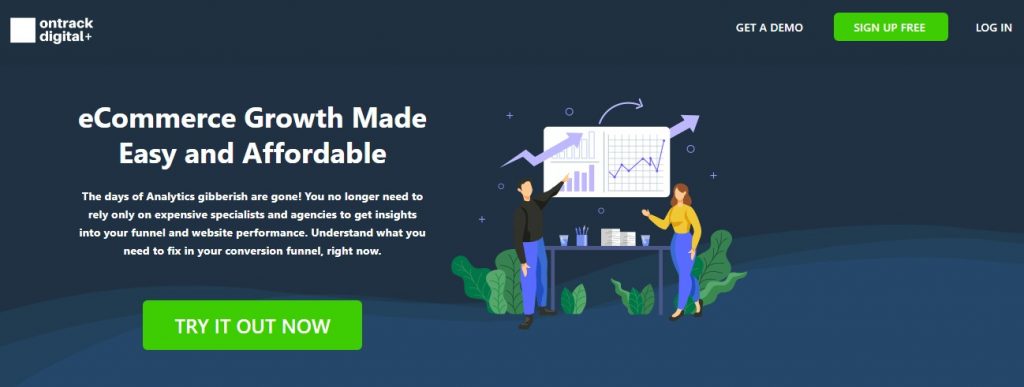The next wave of innovation in CRO that you don’t know about
Conversion rate optimization can be traced back to the beginning of the 20th century. In 1917, the Direct Marketing Association was formed. Even though they did not do CRO, they did A/B split-testing, response tracking, and audience testing to optimize mail, radio, and print campaigns.
Fast forward almost 100 years, after the dot-com bubble burst in 2004, ecommerce businesses needed a way to analyze and improve their websites. This was the moment when Online CRO was born.
With a last leap into time we land to 2019. There are numerous testing platforms right now that provide endless testing possibilities even to non technical people.
Everyone can test button colors, different headers, even add new sections to their websites. But are these small changes going to have any effect on your conversion rate?
You can’t know what works unless you test it
Even twins can be different. Why should you consider that what worked on other businesses will work on yours as well?
You will have to always test new things in order to have the best results.
Booking.com is perhaps one of the best examples. Their company is built on top a testing culture foundation. All of their employees are encouraged to come up with testing hypotheses, as they know that there isn’t a single solution that can magically boost conversion rates.
Since they have hundreds or thousands or tens of hundreds of possible hypotheses making people, they can test up to 50 experiments at the same time.
But coming up with testing hypotheses, YOURSELF, is difficult. If you go with a hunch you might be wrong 50% of the time. If you analyze your users behaviour and then iterate a hypothesis, well, it might also fail.
According to VWO, only 1 in every 7 tests are winners.
So what should you do to take your CRO programme to the next step and outperform your competition?
Test multiple things at the same time (if you’ve got the traffic)
This is a no brainer: testing multiple things at the same time will save time. You just have to be sure that the tests are not affecting each other, and that is hard.
For example, you are testing a CTA color on your landing page right now. The CTA points to a checkout form. At the same time, you decided to test a shorter checkout form to make your users’ lives easier.
After you’ve got enough data to analyze, you discover that the button is a winner and increased the CTR by 30%. Hooray! But these users convert at a very small rate compared to the original button.
Can you know for sure how many users have seen both the new CTA and the new form? Maybe 90% of users who’ve seen the new CTA ended up on the original form.
My point is that without proper analysis you’ll not know for sure what changes you should implement.
But there is a solution: funnel testing.
Be consistent with your tests
Funnel testing allows you to see results based on funnels. If you want to test a new CTA and a new form, on different pages, then implement a funnel test.
This form of testing is not so common. Sure, it can backfire, but if you are stuck in the color testing – headline modifying loop, it can be a breath of fresh air.
Just make sure that you set it up correctly so that you’ll get the most accurate data.
Consistency is the key for a successful marketing strategy. Your brand has the same colors all around. Your next tests should have a nice flow to them.
Multivariate tests should be more common
If you don’t want to test a funnel, and don’t want to test for each button, headline and image one at a time, then this is for you. I believe that MVT (multivariate tests) should definitely be part of any company’s CRO program.
They are not new, but they are also not as common as they should be.
With MVT you can test an unlimited amount of buttons, headlines and images combinations. Depending on the platform that you are using that is.
Google Optimize, in its free plan, allows a maximum of 16 different combinations. That’s like creating 16 different variations, only that you don’t.
You should put MVT on your watch list for your next experiment, and try 3 different headlines with 3 different CTA copy. Or maybe 3 different fonts with 3 different image placements. There are just unlimited combinations. This will save you time and possibly even money. But beware that you should have enough traffic to run 16 different combinations at the same time.
Artificial Intelligence in CRO
Machine learning, auto optimization, laser targeting and one-to-one personalization. These are all buzz words when it comes to AI and CRO.
Everyone would like a little robot to boost their sales. But it’s going to take a little while longer before bots will become sentient beings.
For now though, people have started to develop technologies that will make their lives easier and increase their profits.
There are a few (many) things that AI can do to optimize your conversion rate:
- It can analyze incredibly large data sets so you don’t miss anything;
- It can automatically send personalization to a single users. Like show them what they are most likely to buy;
- It can test thousands of variation at the same time, based on multiple factors;
- It can optimize funnels on the go, for a large number of users.
This sounds really good, but,
Can AI help your CRO programme?
If you have millions of users per month, definitely yes. If you have thousands, then maybe not.
Sure, there are a few apps that can show your users what they are more likely to buy, but that’s about it. The true power of AI might be too expensive for a common store owner, blogger or SaaS platform.
Since you won’t have enough data to feed it, the bot can not grow.
Every AI system, or bot, needs vast data sets to learn from. The more data you feed it, the bigger and stronger it gets.
That’s why, if you don’t have enough food for it, it will remain just too small to be effective.
Now depending on how much you want to spend, you can have your own AI assistant that will help with your CRO efforts. We’ve even created an automated solution that will analyze your data so you don’t have to. It’s built for store owners based on our experience with Shopify stores.
Do you have your own data analyst?
Not many companies can hire a data analyst. And they are mandatory in this era.
A data analyst will analyze your data, dooh. They will come up with insights and point you in the right direction.
With their insights you will be able to optimize your campaigns and tailor them for your audience. But they are usually really expensive.
We wanted to help as many people as possible, so we built Ontrack Analytics App as your personal data analyst.

It will automatically hook to your Google Analytics and give you ad hoc reports about your traffic. Crazy right?
The best part is that you can give it a try for free (for the first 100 users).
Ontrack Analytics App will give you insights about your audience, traffic sources and landing pages. You can see how your website is evolving from month to month, what kind of people are buying the most and where they are coming from.
Stop guessing and act on reliable data. Take a look at your traffic through the eyes of a data analyst and take your marketing efforts to the next level.
We’ll be extremely happy to hear your feedback, so leave a comment below and let us know how Ontrack Analytics App helped you make more money.
